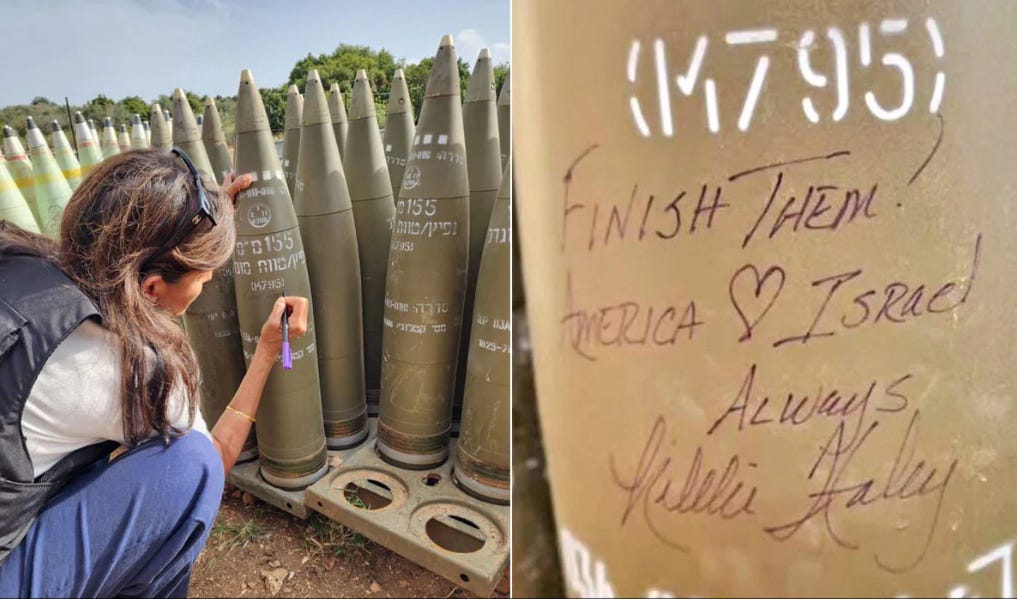Gaslight, gatekeep, genocide: Part 1
Taking stock of the lies, distortions, and half-truths which are peddled by politicians and universities in the name of Israel’s war

On May 9, US President Joe Biden announced a ‘red line’ by declaring that he would limit support for the war in Gaza if Israel launched an invasion of Rafah. Since the outbreak of the war, hundreds of thousands of Palestinian refugees have poured into Rafah from the north of the Gaza strip as the city was initially declared to be a ‘safe zone’ in the conflict. As Biden pledged in an interview with CNN earlier this month:
“I made it clear that if they go into Rafah – they haven’t gone in Rafah yet – if they go into Rafah, I’m not supplying the weapons that have been used historically to deal with Rafah, to deal with the cities – that deal with that problem.”
By taking a stand on Rafah, the president’s remarks signalled a clear shift from the ‘no limits’ policy announced by the Pentagon at the start of the war, when a Defense spokeswoman admitted that the US does not place “any constraints” on the use of weapons supplied to Israel.
But by the time President Biden had issued his warnings, Israel had already begun launching strikes into eastern Rafah, killing dozens and obliterating more than 400 structures. The very next day after Biden’s CNN interview, the president’s own administration declassified an internal report which concluded that “it was “reasonable to assess” that Israel violated international law using U.S. weapons in its military campaign in Gaza”, as reported by The Washington Post.
By the following week, Biden’s national security adviser, Jake Sullivan, was already walking back the president’s ‘red line’ remarks, claiming that Biden “didn’t make any declarations or pronouncements or announcements”. Meanwhile in Rafah, Israeli army forces opened fire on a clearly-marked UN vehicle with shells and grenades, resulting in the death of a UN worker (an IDF investigation into the incident later concluded that Israeli soldiers had breached internal regulations regarding humanitarian workers in the attack). On May 24, the International Court of Justice ordered that Israel “immediately halt its military offensive” in Rafah, citing allegations of genocide.
Then on Sunday, May 26, an Israeli strike in Rafah “ignited a deadly fire and killed at least 45 people, including children, and wounded 249, according to the Gazan health ministry”, the New York Times reported. But despite a mounting global outcry, US officials remained adamant that the deadly strike did not violate President Biden’s ‘red line’. This led to a tense exchange in the press briefing room on Tuesday, when CBS White House Correspondent Ed O’Keefe asked White House spokesman John Kirby, “How many more charred corpses does the president need to see before he considers a change of policy?”
Kirby maintained that there was no “major ground operation” as yet underway in Rafah, and that Israeli tanks remained on the outskirts of the city to “put pressure on Hamas”. That very same day, the Israeli military said in a statement that it was engaging in “close-quarters combat” in Rafah. On Wednesday, Israel’s military said “it has seized control of the entire length of Gaza’s border with Egypt” which includes the Rafah area, as reported by the Associated Press. A separate statement from the military issued yesterday revealed that an IDF tank opened fire on a “suspicious vehicle” in Rafah containing two Palestinian Red Crescent medics who were both killed in the strike.
The following post is the first installment of a multi-part series documenting some of the most egregious and brazen lies which have precipitated the ongoing humanitarian crisis in Gaza. We will begin by getting to the bottom of the Australian government’s attempts to shirk responsibility for arms trading and weapons exports oversight. Subsequent installments will examine the research collaborations and partnerships of Australian universities and weapons manufacturers tied to Israel, as well as the police crackdowns on student demonstrators in university campuses across the globe.
Labor gaslights the Australian public on weapons exports
April 2024 began with the killing of seven aid workers, including one Australian, by an Israeli drone strike, sparking renewed concerns about the military support which Australia provides to Israel. When asked on 8 April if Australia would stop selling arms to Israel in light of the most recent tragedy, Prime Minister Anthony Albanese issued a blunt denial in response: “We of course don't send arms to Israel now, so we haven't done so for some period of years”.
Similar claims have been made by the Minister for Foreign Affairs, Penny Wong, and by the Deputy Prime Minister and Defence Minister, Richard Marles, both of whom continue to deny Australia’s complicity in the genocide unfolding in Gaza. Responding to a question from Senator David Shoebridge (Greens) in February, Senator Wong stated that “Australia has not supplied weapons to Israel since the conflict began and for at least the past five years” (Wong then proceeded to issue a stern warning towards the Senator Shoebridge against contributing to the spread of “disinformation”). Defence Minister Richard Marles also claims that there have been “no exports of weapons from Australia to Israel” for “many, many years”.
However, according to data published by both the Department of Foreign Affairs and Trade (DFAT) and the Australian Bureau of Statistics, exports of “arms and ammunition” from Australia to Israel were in excess of $1.5 million In February of this year alone. Moreover, The Guardian reports that “Australian arms and ammunition exports to Israel totalled $13m over the past five years”, according to “export figures compiled by the Department of Foreign Affairs and Trade”. Between 2017 and March 31, 2023, there were 322 military export permits issued in relation to Israel, and 52 last year, including permits granted after October 7th.
So what accounts for this discrepancy between the statements of government officials and the government’s own export commodities data from its own official federal agencies?
The Albanese Labor government and the Department of Defence continue to hide behind an extremely narrow definition of “weapons” which is then used to argue that Australia’s material support for Israel does not constitute the trafficking of “lethal equipment”. When Senator Shoebridge, at a senate estimates hearing last month, quizzed a top Defence mandarin on whether or not the Australian-made bay doors of a F-35 fighter jet which are used to release bombs could be considered a “weapon”, the reply was Kafkaesque.
Hugh Jeffrey, a senior Department of Defence official, responded by glibly likening the offensive capability of the bomb bay of a fighter jet to the pointy end of a grey lead pencil, as reported in the Sydney Morning Herald:
“A pencil is used for writing,” Jeffrey said to explain the distinction. “It’s not designed, in and of itself, to be a weapon, but it can be, if you want to use it as a weapon.”
The bay doors of a F-35 fighter jet are used, then, simply for creating a small opening at the bottom of the aircraft. If a 2,000-pound bunker-buster bomb just so happens to slip out of one of these bay doors and pulverise some Gazan toddlers huddling in a tent encampment 10,000 feet below — tragic, perhaps, but at least you can’t say we sold Israel a weapon.
Unsurprisingly, the denials by Albo and his cabinet ministers have been directly contradicted by a panel of UN experts who designate Australia as a “military exporter” to Israel, alongside France, the United Kingdom, and Canada. Will Penny Wong now claim that UN Special Rapporteurs (or DFAT, for that matter) are also in the business of disseminating “disinformation” like her colleague Senator Shoebridge?
Nor can the government hide behind the fact that Australia’s defence exports to Israel are miniscule, at least in terms of dollar value, when compared to those supplied by the United States and Germany. This ‘drop in the ocean’ defence obscures the reality that Australia plays a major role in the global supply chain for the manufacturing of F-35 fighter jets, aircraft which Israel heavily relies upon to carry out its aerial bombardment of Gaza.
Or at least that's what you would have found out until just recently by simply reading the official website of weapons manufacturer Lockheed Martin — Its ‘Australia’ page has since been edited without explanation to remove the following statement, which can still be viewed through the Wayback Machine web archive:
“As a programme partner, Australian businesses are supplying components for the entire F-35 fleet, not just Australian aircraft. Every F-35 built contains some Australian parts and components.” [emphasis added]
As independent weapons industry researcher Michelle Fahy points out, the F-35 fighter jet program operates with a ‘just in time’ supply chain which means that it is particularly vulnerable to disruption. Two export permit approvals issued by the Australian Department of Defence for Israel since last October therefore appear to “have been related to the US-led rush to organise increased supply of F-35 spare parts for Israel”, according to Fahy. Meanwhile, in February of this year, a Dutch court ruled that the Netherlands must cease exporting parts for the F-35, citing “a clear risk that Israel’s F-35 fighter jets might be used in the commission of serious violations of international humanitarian law.”
But Australian military support for Israel doesn’t stop at F-35s (or with lethally-sharpened 2B pencils). The Israeli weapons company, Elbit Systems, was awarded a $917 billion Australian army contract in February, despite concerns about the firms’ technology compromising sensitive data which led to a “cease use” directive in 2021, and despite Elbit Systems’ role in manufacturing the deadly Hermes 450 drone — the very same weapon used by Israel in the killing of Australian aid-worker Zomi Frankcom in April.
Contrary to Defence Minister Richard Marles’ claims that “Australia's defence export control regime is one which is thorough and detailed”, senior analysts from the Australian Strategic Policy Institute have raised concerns about the lack of transparency and accurate data when it comes to Australia’s military exports, noting that not even the Department of Defence is aware of all the defence exports which emanate from Australian companies. This is partly because many defence exports originating in Australia are likely being laundered through third-party firms overseas, which integrate smaller components like computer chips into larger weapons systems.
But greater transparency would, of course, make it harder for the government to equivocate on Australia’s military involvement with Israel. Claims by the Prime Minister and his cabinet that Australia provides no weapons to Israel rely upon a sordid rhetorical trick which is designed to absolve the federal government and Australians businesses of liability for the worsening humanitarian crisis in Gaza.
Transparency is also at the heart of the demands of ‘Unimelb for Palestine’, a student activist group at the University of Melbourne which recently declared a “major win” following eight months of campaigning. The next installment of this series will delve into the university’s misleading and contradictory characterisation of its collaboration with weapons manufacturers, while documenting its attempts to demonise the recent attempts of student activists to call for disclosure and divestment.

